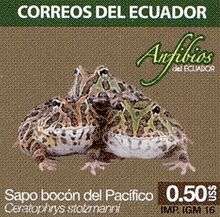Pacific horned frog
The Pacific horned frog (Ceratophrys stolzmanni), also known as Pacific big-mouthed frog, Stolzmann's horned frog and Ecuadorian horned frog, is a species of frog in the family Ceratophryidae. It is found in Ecuador and Peru. Its natural habitats are subtropical or tropical dry forest, subtropical or tropical dry shrubland, and sandy shores. Its geographical range is very fragmented; it has a total area of about 20,000 km2 and is continuously shrinking due to human activities.[1]
| Pacific horned frog | |
|---|---|
 | |
| Scientific classification | |
| Kingdom: | Animalia |
| Phylum: | Chordata |
| Class: | Amphibia |
| Order: | Anura |
| Family: | Ceratophryidae |
| Genus: | Ceratophrys |
| Species: | C. stolzmanni |
| Binomial name | |
| Ceratophrys stolzmanni Steindachner, 1882 | |
Reproduction
Breeding is triggered by heavy rain fall and Pacific horned frogs reproduce explosively over the course of a single night. Typically, Pacific horned frogs lay underground during day and they are most active after sundown. Male frogs reproduce by approaching females both on land and shallow water and clasp on to the female, in a variation of axillary amplexus, in other word called "neck amplexus".[2]
References
| Wikimedia Commons has media related to Ceratophrys stolzmanni. |
- Ariadne Angulo, Luis A. Coloma, Santiago Ron, Diego Cisneros-Heredia (2004). Ceratophrys stolzmanni. The IUCN Red List of Threatened Species doi:10.2305/IUCN.UK.2004.RLTS.T56341A11464974.en
- Székely D, Székely P, Denoël M, Cogălniceanu D. Random size-assortative mating despite size-dependent fecundity in a Neotropical amphibian with explosive reproduction. Ethology. 2018;124:218–226. https://doi.org/10.1111/eth.12724
